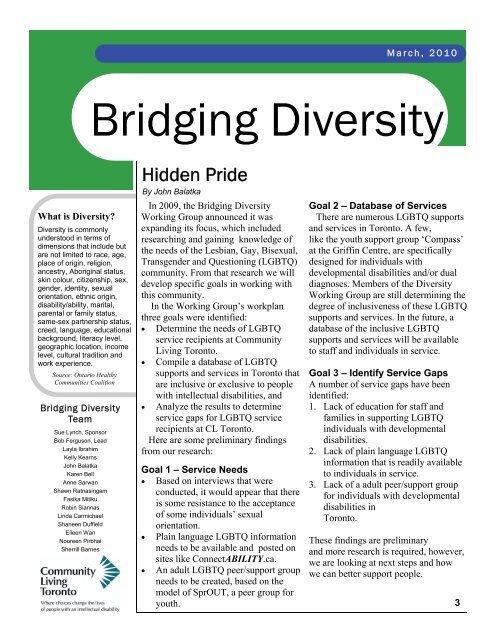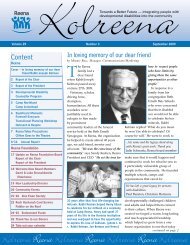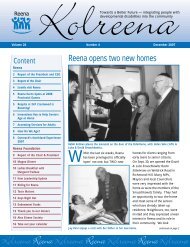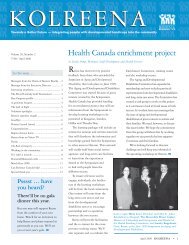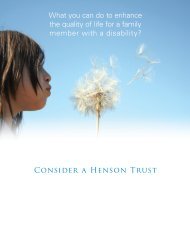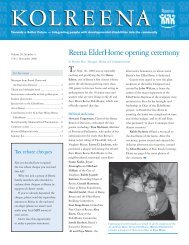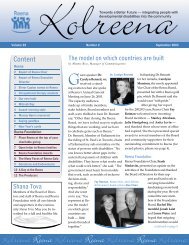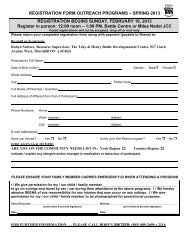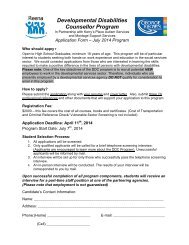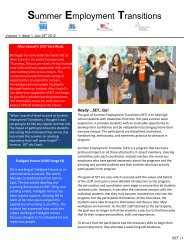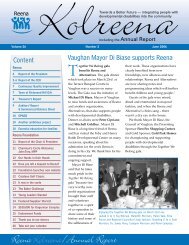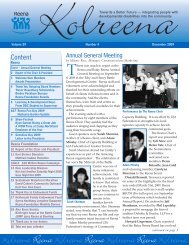Connections PDF - Reena
Connections PDF - Reena
Connections PDF - Reena
You also want an ePaper? Increase the reach of your titles
YUMPU automatically turns print PDFs into web optimized ePapers that Google loves.
March, 2010<br />
Bridging Diversity<br />
What is Diversity<br />
Diversity is commonly<br />
understood in terms of<br />
dimensions that include but<br />
are not limited to race, age,<br />
place of origin, religion,<br />
ancestry, Aboriginal status,<br />
skin colour, citizenship, sex,<br />
gender, identity, sexual<br />
orientation, ethnic origin,<br />
disability/ability, marital,<br />
parental or family status,<br />
same-sex partnership status,<br />
creed, language, educational<br />
background, literacy level,<br />
geographic location, income<br />
level, cultural tradition and<br />
work experience.<br />
Source: Ontario Healthy<br />
Communities Coalition<br />
Bridging Diversity<br />
Team<br />
Sue Lynch, Sponsor<br />
Bob Ferguson, Lead<br />
Layla Ibrahim<br />
Kelly Kearns<br />
John Balatka<br />
Karen Bell<br />
Anne Sarwan<br />
Shawn Ratnasingam<br />
Fasika Mitiku<br />
Robin Siannas<br />
Linda Carmichael<br />
Shaneen Duffield<br />
Eileen Wan<br />
Nooreen Pirbhai<br />
Sherrill Barnes<br />
Hidden Pride<br />
By John Balatka<br />
In 2009, the Bridging Diversity<br />
Working Group announced it was<br />
expanding its focus, which included<br />
researching and gaining knowledge of<br />
the needs of the Lesbian, Gay, Bisexual,<br />
Transgender and Questioning (LGBTQ)<br />
community. From that research we will<br />
develop specific goals in working with<br />
this community.<br />
In the Working Group’s workplan<br />
three goals were identified:<br />
Determine the needs of LGBTQ<br />
service recipients at Community<br />
Living Toronto.<br />
Compile a database of LGBTQ<br />
supports and services in Toronto that<br />
are inclusive or exclusive to people<br />
with intellectual disabilities, and<br />
Analyze the results to determine<br />
service gaps for LGBTQ service<br />
recipients at CL Toronto.<br />
Here are some preliminary findings<br />
from our research:<br />
Goal 1 – Service Needs<br />
Based on interviews that were<br />
conducted, it would appear that there<br />
is some resistance to the acceptance<br />
of some individuals’ sexual<br />
orientation.<br />
Plain language LGBTQ information<br />
needs to be available and posted on<br />
sites like ConnectABILITY.ca.<br />
An adult LGBTQ peer/support group<br />
needs to be created, based on the<br />
model of SprOUT, a peer group for<br />
youth.<br />
Goal 2 – Database of Services<br />
There are numerous LGBTQ supports<br />
and services in Toronto. A few,<br />
like the youth support group ‘Compass’<br />
at the Griffin Centre, are specifically<br />
designed for individuals with<br />
developmental disabilities and/or dual<br />
diagnoses. Members of the Diversity<br />
Working Group are still determining the<br />
degree of inclusiveness of these LGBTQ<br />
supports and services. In the future, a<br />
database of the inclusive LGBTQ<br />
supports and services will be available<br />
to staff and individuals in service.<br />
Goal 3 – Identify Service Gaps<br />
A number of service gaps have been<br />
identified:<br />
1. Lack of education for staff and<br />
families in supporting LGBTQ<br />
individuals with developmental<br />
disabilities.<br />
2. Lack of plain language LGBTQ<br />
information that is readily available<br />
to individuals in service.<br />
3. Lack of a adult peer/support group<br />
for individuals with developmental<br />
disabilities in<br />
Toronto.<br />
These findings are preliminary<br />
and more research is required, however,<br />
we are looking at next steps and how<br />
we can better support people.<br />
3


